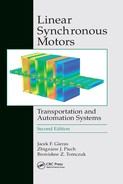Preface to the 2nd Edition
Twelve years have passed since the publication of the first edition of this book in 1999.
The growth in demand for linear motors is principally driven by the replacement of traditional mechanical (ball screws, gear trains, cams), hydraulic, or pneumatic linear motion systems in manufacturing processes, machining, material handling, and positioning with direct electromechanical drives. The linear motor market heavily depends on the semiconductor industry (applications) and permanent magnet industry (linear motors manufacture). A recent market study1 shows that linear motors have impacted the linear motion market less than expected. The main obstacle that makes companies reluctant to replace mechanical, hydraulic, and pneumatic actuators with linear electric motors is the higher initial cost of installation of direct linear motor drives as compared to traditional mechanical drives.
The North American market for linear motors totaled only US$ 40 million in 1999 and grew by over 20% annually to reach the size of US$ 95 million in 2004. In the same year, the European linear motor market reached the size of US$ 114 million [67]. These numbers do not include special applications and large linear motors (rollercoasters, people movers, military applications). In 2007, the worldwide linear motor component market was estimated at about US$ 230 million, and the worldwide linear motor system market at about US$ 400 million [42]. The worldwide linear motor markets estimated growth between 2007 and 2009 was over 10% for components and over 15% for systems. Linear motors sales fell by close to 50% in 2009 due to global economic recession. The first signs of recovery were visible in the 2nd quarter of 2010. In the future, the main market players will be those manufacturers who can offer complete direct-drive systems.
All the above numbers are very small in comparison with the world market for standard rotary electric motors. The worldwide market for electric motors grew from US$ 12.5 billion in 2000 to US$ 19.1 billion in 2005 and is predicted to reach US$ 39.1 billion by the year 2015.
In comparison with the 1st edition of this book, the 2nd edition has been thoroughly revised and expanded, Chapter 4, Chapter 5, Appendix D, and List of Patents have been added, and at the end of each chapter, examples of calculations or mathematical models have been added.
The authors hope that the improved and updated new edition of Linear Synchronous Motors will find broad readerships including engineers, researchers, scientists, students, and all enthusiasts of linear motors and direct drives.
Prof. Jacek F. Gieras, FIEEE
e-mail: [email protected]
Connecticut, June 2011
1IMS Research, Wellingborough, UK
